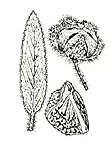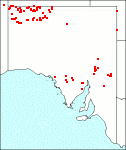Family: Malvaceae
Sida phaeotricha
Citation:
F. Muell., Linnaea 25:382 (1853).
Synonymy: ?S. cryphiopetala F. Muell., Fragm. Phyt. Aust. 3:4 (1862); S. virgata Hook. var. phaeotricha (F. Muell.)Benth., Fl. Aust. 1:194 (1863).
Common name: Hill sida.
Description:
Shrubs often c. 1 m high but up to 2.5 m, densely stellate-tomentose with golden or ferruginous hairs on the younger parts; leaf blades usually one and a half to two times as long as the petioles, oblong to ovate-lanceolate, 10-75 x 2-24 mm, obtuse or cordate at the base, bluntly or acutely dentate with 6-12 teeth/cm to subentire, densely velvety-tomentose.
Flowers solitary in the axils of leaves or in axillary clusters of 2-6 through an association with developing shoots, on articulated peduncles 4-20 mm long; calyx 5-10 mm long, not greatly enlarging in fruit, densely tomentose, with lobes divided to about the middle, acute or acuminate, clasping the fruit; corolla 7-12 mm long, yellow.
Schizocarp transverse-ellipsoid, raised apically, pubescent, 4-6 mm diam., slightly wrinkled on the circumference, the 5 rarely 6 mericarps honey-combed on their sides.

| Sida phaeotricha leaf, fruit and mericarp.
|
Image source: fig 440k in Jessop J.P. & Toelken H.R. (Ed.) 1986. Flora of South Australia (4th edn).
|
|
|
Distribution:
|
Usually occurs on rocky slopes.
S.Aust.: NW, FR, EA, EP. W.Aust.; N.T.; N.S.W.
|
Conservation status:
native
Flowering time: recorded mainly July — Oct.
|

SA Distribution Map based
on current data relating to
specimens held in the
State Herbarium of South Australia
|
Biology:
No text
Taxonomic notes:
As proposed by Mitchell in Jessop (1981) Flora of central Australia S. cryphiopetala and S. phaeotricha are treated as likely to be synonymous and the earlier name is therefore adopted here. Specimens from the Everard Range (NW) with a lighter coloured finer tomentum and only 1-3 mericarps developing in fruit may represent a distinct taxon.
Author:
Not yet available
|

